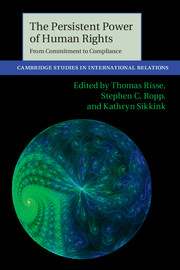Book contents
- Frontmatter
- Contents
- Figures
- Tables
- Contributors
- Preface
- Part I Introduction and stock-taking
- Part II Conceptual and methodological issues
- Part III From ratification to compliance
- Part IV From commitment to compliance
- 11 Encouraging greater compliance
- 12 Business and human rights
- 13 Taming of the warlords
- 14 Changing hearts and minds
- 15 Conclusions
- References
- Index
11 - Encouraging greater compliance
Local networks and the United Nations Global Compact
Published online by Cambridge University Press: 05 March 2013
- Frontmatter
- Contents
- Figures
- Tables
- Contributors
- Preface
- Part I Introduction and stock-taking
- Part II Conceptual and methodological issues
- Part III From ratification to compliance
- Part IV From commitment to compliance
- 11 Encouraging greater compliance
- 12 Business and human rights
- 13 Taming of the warlords
- 14 Changing hearts and minds
- 15 Conclusions
- References
- Index
Summary
Human rights norms are today a central aspect of the corporate social responsibility (CSR) agenda. After decades of exclusive attention to the behavior of states, human rights activists began during the late 1980s and 1990s to increase their pressures on corporate actors and demand commitment to and compliance with basic human rights in the business world. Unlike states, corporations lack international legal personality and cannot express commitment by signing on to formal international human rights treaties. Apart from voluntary standards, codes of conduct, and other United Nations standard-setting activities directed at businesses (Mantilla 2009), the Global Compact (GC) represents to date the main UN-sanctioned soft law designed to commit corporations to international standards of human rights and environmental protection. The GC does not replace the main compliance mechanisms set out by the legal obligations assumed by states under international law, but its goal is to supplement those existing mechanisms with an additional, non-binding avenue of promoting universal human rights principles (Rasche 2009; Shelton 2000).
The GC has attracted the most diverse membership, making it the “world’s leading corporate citizenship initiative” (Annan 2006). With its emphasis on corporate citizenship, not legal accountability, as well as low entry barriers and minimal reporting requirements, the Compact offers a compelling test case for the significance of discourses, learning, and capacity-building as pathways to compliance. The GC pursues an explicit strategy of using low entry barriers as well as “norm diffusion and the dissemination of practical know-how and tools” (Ruggie 2007: 820) to quickly expand the reach of its norms into the corporate sector. It uses non-coercive measures for achieving its goals by creating incentives connected to a firm’s reputation-building efforts. But commitment to norms is meaningless if it does not have an impact on the behavior and compliance of private actors. In this chapter, we focus on compliance and ask if membership in the GC has a positive impact on the behavior of corporations or is merely a public relations stunt designed to “blue-wash” their image by adding the UN logo to the corporate social responsibility (CSR) statements.
- Type
- Chapter
- Information
- The Persistent Power of Human RightsFrom Commitment to Compliance, pp. 203 - 221Publisher: Cambridge University PressPrint publication year: 2013
- 10
- Cited by

